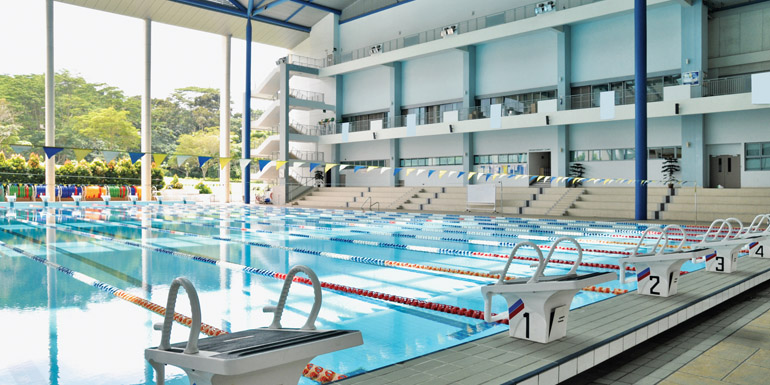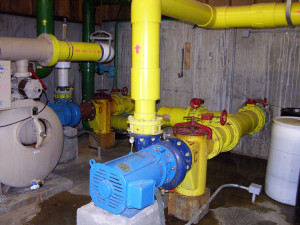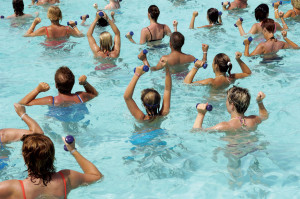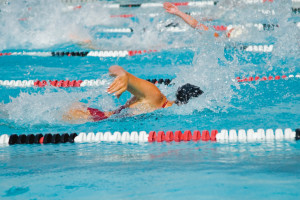How Much Does It Cost To Fill An Olympic Sized Pool

By Roy D. Vore, PhD
When it comes to water maintenance, a pool is just a pool, right? Just how about treating and managing a l-m (164-ft) Olympic pool with one,135,624 Fifty (300,000 gal) of water, which must be sparkling clear every day? Regardless of a pool's water book, disinfection, water balance, and filtration remain the same.

Nevertheless, a casual stroll through the pump room of i these massive facilities can be quite eye opening and exit one to remember differently. For case, they do not apply typical 1-horsepower (hp) pumps and 23-kg (fifty-lb) sand filters, nor can a maintenance professional person quickly modify the filter sand with a 'shop vac'—recall rather wheel barrows, shovels and skid loaders.
To put this into farther perspective, should an operator find sorting out unlabelled plumbing at a mid-sized hotel pool challenging, consider what it would exist like at an Olympic aquatic facility, which uses 305-mm (12-in.) lines and has a maze of piping.
And even though inventory control and chemical storage for maintaining a hotel pool can prove challenging, endeavour treatment ane,361 kg (3,000 lbs) of sodium bicarbonate (NaHCO3), 757 L (200 gal) of muriatic acid (hydrochloric acid), 378 L (100 gal) of sodium hydroxide (NaOH), 2,000 kg (907 lbs) of calcium chloride (CaClii) and gas chlorine (Cl), and 45 kg (100 lbs) of calcium hypochlorite (Ca[ClO]two), which would be routinely stocked for a typical Olympic-sized aquatic facility.
This brings new pregnant to containment, employee hazard and communication training, and safety. Despite their size, even so, Olympic aquatic facilities are simply an overgrown 'big blood brother' to mid-size pools. The fundamentals remain the aforementioned; however, managing them is another issue.
A typical water treatment government
Disinfection systems must be automated and sized appropriately to meet each facility'south varying swim loads. It goes without saying that hand feeding chemicals is not appropriate. In that location are no special requirements for testing chlorine concentration; the same periodic manual testing using North, N-diethyl-p-phenylenediamine (DPD) or ferrous ammonium sulfate-Northward, N-diethyl-p-phenylenediamine (FAS-DPD) must be performed to confirm the settings in the automated chemical feed system.
Manual tests should be performed every two hours, or as specified by local lawmaking if less than ii hours. In polling several facilities, it was adamant most keep free chlorine levels under 2 milligrams per litre (mg/L) or parts per million (ppm) with the understanding that higher levels could atomic number 82 to higher amounts of airborne chloramines.
Water residue parameters and disinfection requirements practise not change with pool size either. As Michael Orr, executive manager of the Foundation for Pool & Spa Industry Education (FPSIE) points out, 1 of the easiest ways to lose control is past calculation large amounts of whatever water balance chemical to the puddle over a brusque flow of time. In doing so, information technology may accept numerous days to straighten out.
Facility management on a grand scale
The real complexity of operating an Olympic-sized facility is not necessarily related to water treatment but rather coming together the requirements of its diverse grouping of patrons, while balancing the personalities of its large staff. Although these are non treatment parameters as such, they are vital to a facility's polish and efficient operation.
Keeping patrons happy

Due to their size, for example, many Olympic facilities must exist able to attract and maintain the attention of a variety of special interest groups as they are vital sources of revenue. Therefore, every bit with any facility, scheduling is important—especially in shared facilities where conflict of interest tin often occur.
For example, youth swimming classes and aquatic exercise programs for older patrons may adopt water temperatures between 28.three and thirty C (83 to 86 F), while swim teams prefer water temperatures ranging from 25.five to 27.vii C (78 to 82 F). Failure to hit the platonic temperature range for each scheduled grouping will not only result in frustrated patrons, but besides disappointed management. Immediately before, during, and after each event the entire focus must be on the requirements of each scheduled grouping. One way to clarify the facility's goals is to publish, distribute, and discuss with all involvement groups, a clear mission statement.
Pages: 1 2 3
How Much Does It Cost To Fill An Olympic Sized Pool,
Source: https://www.poolspamarketing.com/trade/operating-an-olympic-sized-pool/
Posted by: rawlsparunt.blogspot.com


0 Response to "How Much Does It Cost To Fill An Olympic Sized Pool"
Post a Comment